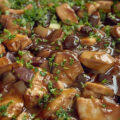When I was a child, had you asked me about the first time a sandwich was mentioned in Jewish history, it’s quite possible I would have referenced a children’s show I used to watch that featured animated biblical stories. Likely, I would have said that the first Jewish mention of the food happened when Queen Vashti was thrown out of the palace in Persia for refusing to make the king a sandwich (part of the way they showed the story of Purim and the book of Esther).
Luckily, June Hersh clears a historical fact up for me in her brand-new book Iconic New York Jewish Food. She writes that “according to Ted Merwin, the first sandwich can be traced to Hillel the Elder at the turn of the first millennium. Hillel wrapped herbs and shredded lamb in what most assume was a soft version of matzo.” Now that sounds familiar. Since then, although a bit more evolved, sandwiches have been a staple in Jewish deli cuisine.
![]()
The story of Hillel’s korech isn’t the only time that Hersh connects stories or ancient texts from the Torah to modern day food we consider Jewish. In Iconic New York Jewish Food, we learn that Rabbi Solomon ben Isaac interpreted a passage from Genesis where Abraham serves mustard with tongue to the three angels that announced the birth of Jacob. Hersh claims it is basically a commandment to do the same today.
In fact, the way Hersh gracefully glides between past, and present is one of the most captivating parts of the book. Each chapter of the book begins with a history lesson; readers discover how specific food items made their way from Europe to New York. Food considered so New York, is really so Poland, Ukraine, Russia, Germany, Spain, and many other places where they originated. Each chapter concludes with a recipe for readers to make in their own home kitchens. For you purists out there, you can take assurance in the fact that Hersh chose recipes which aren’t “newfangled or profound reinterpretations; no deconstructed knishes or jalapeno matzo balls.” There might be a time and place for those recipes, but Hersh takes pride in the recipes she shares being authentic and rooted in tradition. Although some photos are small and difficult to see, these recipes are straightforward and easy to follow, compiled from a variety of sources.
![]()
Make your own bagel chips.
While at times the book may read more like a history guidebook than a cookbook, Hersh inserts her first-person voice throughout to ensure the pages are filled with humor. She compares the Jewish deli to a Broadway show filled with flashing neon lights, costumes, and character roles. Readers can clearly visualize the notorious pushcarts that filled the Lower East Side, selling pickles, hot dogs, and pretzels. By the time you learn all about bagels, knishes, several types of fish, and Egg Creams, your mouth will be watering and there is nothing you will want more than a big, juicy bite of New York Jewish food.
![]()
Try her recipe for pushcart puppies to bring you back to the streets of NY anytime.
For anyone who grew up with Ashkenazi grandparents, lived in New York, or has visited any of the long-existing classic Jewish food institutions in the city, this book is a trip down memory-lane. Even so, Hersh manages to throw in some surprises. For instance, did you know that chicken soup, which is often thought to be the legacy of Ashkenazi Jews, was actually first called Jewish Penicillin by Sephardi Jews, and was a big part of Sephardi culture long before it was Ashkenazi? To learn more historical secrets and Jewish New York food legacies, you’ll just have to read Hersh’s book yourself!















